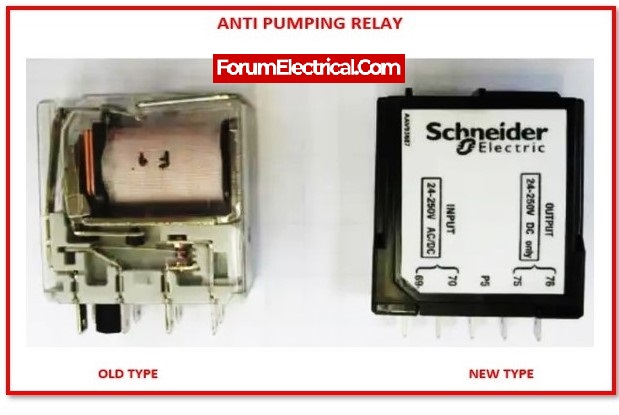Anti-Pumping Relay:
Anti-pumping relays are used in circuit breakers to prevent the breaker from closing unexpectedly after tripping. If the TNC switch fails (Trip normal close) or there is any problem with the CB (circuit breakers) closing circuit, the continuous CB (circuit breakers) close command can be extended to the closing coil. In that circumstance, after tripping the circuit breaker is automatically closed for the persistent close instruction. The unintentional closure of the circuit breaker may pose a safety risk and cause the equipment to fail.
Anti – Against
Pumping – Injecting
- The relay protects the circuit from current/voltage injection.
- It should be wired in series with the protective coil.
- It does not require the installation of any other auxiliary relays. The breaker contact can also be connected by wiring multiplier relays based on requirements.
The anti-pumping relay is essentially a NO (Normally Open) contact in its operational state. This indicates that the relay will be in the NO condition when the circuit breaker is in the closed state. Similarly, the relay will be in the NC (Normally Closed) condition when the circuit breaker (CB) is in the open state condition.
Anti-pumping relays are required for every possible type of circuit breaker closing circuit.

Working Principle of Anti-Pumping Relay:
Typically, a DC contactor serves as the anti-pumping relay in a circuit breaker. As shown in the diagram, the relay’s NC (normally closed) contact is used in series with the CB closing coil. In the circumstance that the relay is not activated, the CB closing DC can be continued to the closing coil. If the relay is activated, the NC contact will become NO (normally open), breaking the DC of the CB closing circuit.
DC closing command is utilised to power the Anti pumping relay. As shown in the diagram, NO contact of the CB auxiliary switch, which varies according to the open-close state of the CB. The relay’s NO contact, and its location changes according to the relay’s operation.

Typically, the CB close instruction is issued for 100 milliseconds to operate the close coil. After the CB was closed, NO contact turned NC contact. If the DC close command is continuous and the CB is in the closed position, the CB close command DC can be prolonged to the relay, which will then operate.
After the relay was activated, the breaker contact changed to the NC position and the DC was also extended through the breaker contact. After activating the CB, the position of the changed to NO. However, the Anti-pumping relay is in operation and will prevent the CB from closing further.
Closing and Trip function of Anti Pumping Relay:

Where,
52a – AC circuit breaker position (contact open / circuit breaker open)
52b – AC circuit breaker position (contact closed / circuit breaker open)
94 – Tripping (or) Trip-Free Relay
As per ANSI Standards.
a). Closing Function:
The circuit breaker is represented in the diagram as closed. When the TNC switch is moved to the close position while aux contact 52b remains in the NC position, the breaker is closed and a contact changeover occurs, resulting in the opening of the 52b contact and the closing of the 52a contact of the trip circuit.
b). Tripping Function:

The above diagram explains how the trip operates. If there is any kind of fault occurs in the relay, the contacts will change to the NC position, which will energise the trip coil. Auxiliary contact 52a was in a close condition prior to the trip.
Which classification is anti pumping relay?
The anti pumping relay belongs to the category of auxiliary relays, which are designed to operate in response to the opening or closing of the operational circuit in order to boost the functionality of another relay or device. Timers, contact-multiplier relays, sealing units, isolating relays, lockout relays, and trip relays are some of the components that fall under the category.
What does anti-pumping represent in closing the circuit breaker?
The mechanical anti-pumping mechanism ensures that a circuit breaker receiving consecutive opening and closing orders does not open and close continuously.
If there is a continuous closing order, the circuit breaker stays open until the order is discontinued. A new (closing) order is required to close the circuit breaker. A new order is not essential if the closing release is wired in series with PF “ready to close” contact.









